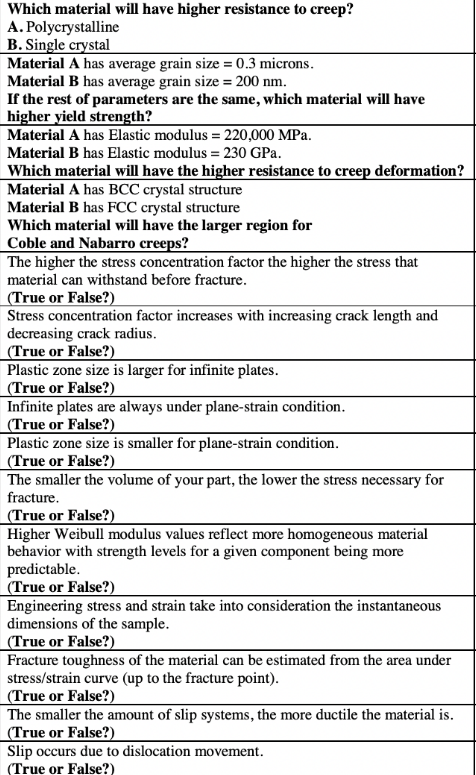Which material will have higher resistance to creep? A. Polycrystalline B. Single crystal Material A has average grain size = 0.3 microns. Material B has average grain size = 200 nm. If the rest of parameters are the same, which material will have higher yield strength? Material A has Elastic modulus = 220,000 MPa. Material B has Elastic modulus = 230 GPa. Which material will have the higher resistance to creep deformation?
Which material will have higher resistance to creep? A. Polycrystalline B. Single crystal Material A has average grain size = 0.3 microns. Material B has average grain size = 200 nm. If the rest of parameters are the same, which material will have higher yield strength? Material A has Elastic modulus = 220,000 MPa. Material B has Elastic modulus = 230 GPa. Which material will have the higher resistance to creep deformation?
Principles of Instrumental Analysis
7th Edition
ISBN:9781305577213
Author:Douglas A. Skoog, F. James Holler, Stanley R. Crouch
Publisher:Douglas A. Skoog, F. James Holler, Stanley R. Crouch
Chapter7: Components Of Optical Instruments
Section: Chapter Questions
Problem 7.14QAP
Related questions
Question
help

Transcribed Image Text:Which material will have higher resistance to creep?
A. Polycrystalline
B. Single crystal
Material A has average grain size = 0.3 microns.
Material B has average grain size = 200 nm.
If the rest of parameters are the same, which material will have
higher yield strength?
Material A has Elastic modulus = 220,000 MPa.
Material B has Elastic modulus = 230 GPa.
Which material will have the higher resistance to creep deformation?
Material A has BCC crystal structure
Material B has FCC crystal structure
Which material will have the larger region for
Coble and Nabarro creeps?
The higher the stress concentration factor the higher the stress that
material can withstand before fracture.
(True or False?)
Stress concentration factor increases with increasing crack length and
decreasing crack radius.
|(True or False?)
Plastic zone size is larger for infinite plates.
(True or False?).
Infinite plates are always under plane-strain condition.
|(True or False?)
Plastic zone size is smaller for plane-strain condition.
(True or False?)
The smaller the volume of your part, the lower the stress necessary for
fracture.
|(True or False?)
Higher Weibull modulus values reflect more homogeneous material
behavior with strength levels for a given component being more
predictable.
| (True or False?)
Engineering stress and strain take into consideration the instantaneous
dimensions of the sample.
(True or False?)
Fracture toughness of the material can be estimated from the area under
stress/strain curve (up to the fracture point).
(True or False?)
|The smaller the amount of slip systems, the more ductile the material is.
(True or False?)
Slip occurs due to dislocation movement.
(True or False?)
Expert Solution
This question has been solved!
Explore an expertly crafted, step-by-step solution for a thorough understanding of key concepts.
This is a popular solution!
Trending now
This is a popular solution!
Step by step
Solved in 3 steps with 3 images

Knowledge Booster
Learn more about
Need a deep-dive on the concept behind this application? Look no further. Learn more about this topic, chemistry and related others by exploring similar questions and additional content below.Recommended textbooks for you

Principles of Instrumental Analysis
Chemistry
ISBN:
9781305577213
Author:
Douglas A. Skoog, F. James Holler, Stanley R. Crouch
Publisher:
Cengage Learning

Chemistry for Engineering Students
Chemistry
ISBN:
9781337398909
Author:
Lawrence S. Brown, Tom Holme
Publisher:
Cengage Learning

Principles of Instrumental Analysis
Chemistry
ISBN:
9781305577213
Author:
Douglas A. Skoog, F. James Holler, Stanley R. Crouch
Publisher:
Cengage Learning

Chemistry for Engineering Students
Chemistry
ISBN:
9781337398909
Author:
Lawrence S. Brown, Tom Holme
Publisher:
Cengage Learning